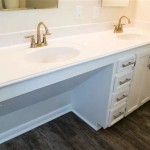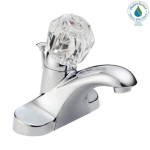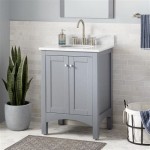Pictures of Bathrooms With Pedestal Sinks: A Design Exploration
Pedestal sinks, characterized by their freestanding design where the basin sits atop a supporting pedestal, offer a distinct aesthetic and functional appeal to bathrooms. Pictures of bathrooms featuring pedestal sinks showcase their versatility, ranging from classic and traditional styles to more modern and minimalist interpretations. This article will explore various aspects of bathroom design incorporating pedestal sinks, covering stylistic considerations, space optimization, and practical implications for homeowners.
The visual impact of a pedestal sink is significant. Unlike vanity sinks that are integrated into cabinetry, pedestal sinks expose the plumbing beneath, which can either be concealed with decorative shrouds or embraced as part of a rustic or industrial design. This feature contributes to the sink's overall aesthetic, influencing the surrounding fixtures and décor. The choice of pedestal sink design, whether ornate or streamlined, directly impacts the bathroom's ambiance.
Stylistic Considerations for Pedestal Sinks
The selection of a pedestal sink hinges heavily on the desired bathroom style. For traditional bathrooms, pedestal sinks with detailed moldings, claw feet, and classic silhouettes are popular choices. These sinks often pair well with vintage-inspired faucets, sconces, and wainscoting. Materials like porcelain and cast iron are commonly used to achieve an authentically traditional aesthetic.
In contrast, modern bathrooms often feature pedestal sinks with clean lines, geometric shapes, and minimalist designs. These sinks are typically constructed from materials like glass, stainless steel, or composite materials, reflecting a more contemporary aesthetic. Faucets with sleek, single-lever designs and chrome or brushed nickel finishes complement the modern look. These minimalist setups prioritize functionality and simplicity, reflecting a clutter-free environment.
Transitional bathrooms, which blend traditional and modern elements, can incorporate pedestal sinks that bridge the gap between these two styles. These sinks might feature simple pedestal designs with subtle curves or details, offering a balanced aesthetic. Neutral color palettes, such as grays, whites, and beiges, are often used in transitional bathrooms to create a cohesive and calming atmosphere.
Beyond the core stylistic categories, pedestal sinks can also be incorporated into various niche designs. For example, a rustic bathroom might feature a pedestal sink made from reclaimed wood or with a distressed finish. An industrial-style bathroom might opt for a pedestal sink with exposed plumbing and a concrete or metal basin. The adaptability of pedestal sinks allows them to seamlessly integrate into diverse design schemes.
Color plays a crucial role in the overall aesthetic. While white pedestal sinks are a classic and versatile choice, colored sinks can add a pop of personality to the bathroom. Pastel colors, such as light blue or pink, are often used in vintage-inspired bathrooms, while bolder colors, such as black or navy, can create a more dramatic and contemporary look. The choice of color should complement the surrounding tiles, paint, and accessories.
The selection of a faucet is just as important as the pedestal sink itself. Faucets come in a wide range of styles, finishes, and functionalities. Traditional faucets often feature cross handles and gooseneck spouts, while modern faucets typically have single-lever controls and minimalist designs. The finish of the faucet should complement the sink and other fixtures in the bathroom.
Accessories also contribute to the overall stylistic coherence. Mirrors, lighting fixtures, and storage solutions should be carefully selected to complement the pedestal sink and the overall bathroom design. A well-chosen mirror can enhance the sense of space and reflect light, while carefully positioned lighting fixtures can create a warm and inviting atmosphere. Storage solutions, such as shelving or baskets, can help to keep the bathroom organized and clutter-free.
Space Optimization with Pedestal Sinks
One of the key advantages of pedestal sinks is their space-saving design. Unlike vanity sinks that require substantial floor space for cabinetry, pedestal sinks have a smaller footprint, making them ideal for small bathrooms or powder rooms. This compact design allows for more open floor space, creating a sense of spaciousness.
In small bathrooms, every inch of space counts. Pedestal sinks can be strategically placed to maximize the available area. Corner pedestal sinks are particularly effective in tight spaces, as they fit neatly into corners without taking up valuable floor space. Wall-mounted pedestal sinks, which are attached directly to the wall without a pedestal base, offer even greater space savings.
While pedestal sinks offer space savings, they also lack built-in storage. This can be a challenge for homeowners who need ample storage for toiletries and other bathroom essentials. To address this, creative storage solutions can be implemented. Wall-mounted shelves, over-the-toilet storage units, and decorative baskets can provide additional storage without compromising the bathroom's aesthetic.
Another approach to maximizing space is to utilize vertical storage. Tall, narrow shelves or cabinets can provide ample storage without taking up much floor space. These storage solutions can be strategically placed to complement the pedestal sink and other fixtures in the bathroom.
Mirrors with built-in storage are also a practical solution for small bathrooms. These mirrors provide a reflective surface while also offering concealed storage for toiletries and other items. This helps to keep the countertop clear and uncluttered, creating a more organized and visually appealing space.
The layout of the bathroom is crucial for optimizing space. The placement of the pedestal sink, toilet, and shower or bathtub should be carefully considered to ensure that there is adequate space for movement and that the layout is both functional and aesthetically pleasing. A well-planned layout can make even the smallest bathroom feel spacious and comfortable.
Light also plays a significant role in creating a sense of spaciousness. Natural light is ideal, but if the bathroom lacks natural light, artificial lighting can be used to brighten the space and make it feel more open. Recessed lighting, sconces, and vanity lights can be strategically placed to illuminate the bathroom and enhance its overall aesthetic.
Practical Implications of Pedestal Sinks
While pedestal sinks offer aesthetic and space-saving advantages, there are also practical implications to consider. The lack of built-in storage is a primary concern for many homeowners. As mentioned earlier, creative storage solutions can help to mitigate this issue, but it is important to carefully consider storage needs when deciding whether to install a pedestal sink.
Another practical consideration is the accessibility of the plumbing. Because the plumbing beneath the pedestal sink is exposed, it is more easily accessible for repairs and maintenance. This can be an advantage for homeowners who prefer to handle minor plumbing issues themselves. However, it also means that the plumbing is more susceptible to damage or freezing in colder climates.
The height of the pedestal sink is another factor to consider. Standard pedestal sinks are typically around 32 inches tall, but taller or shorter models are available. It is important to choose a sink height that is comfortable for all users. For households with children or individuals with mobility issues, a shorter sink may be more appropriate.
The material of the pedestal sink is also a practical consideration. Porcelain and cast iron are durable and easy to clean, but they can be heavy and prone to chipping. Glass pedestal sinks are visually striking but can be more fragile and require more frequent cleaning. Composite materials offer a balance of durability, aesthetics, and ease of maintenance.
The installation of a pedestal sink is typically straightforward, but it is important to ensure that the sink is securely mounted to the wall and floor. This will prevent the sink from wobbling or tipping over. Professional installation is recommended for homeowners who are not experienced with plumbing or construction.
Maintenance of a pedestal sink is generally simple. Regular cleaning with a mild soap and water is sufficient to keep the sink looking its best. Avoid using abrasive cleaners or scouring pads, as these can damage the surface of the sink. For stubborn stains, a solution of vinegar and water can be used.
The cost of a pedestal sink can vary depending on the material, design, and brand. Basic pedestal sinks are relatively inexpensive, while more elaborate or designer models can be quite pricey. It is important to set a budget before shopping for a pedestal sink and to compare prices from different retailers.
Ultimately, the decision of whether to install a pedestal sink is a personal one that depends on individual needs and preferences. By carefully considering the stylistic considerations, space optimization, and practical implications, homeowners can make an informed decision that will enhance the beauty and functionality of their bathroom.

Four Pedestal Sinks In Very Diffe Bathrooms One Week Bath

Hanikes 20 1 2 In White Vitreous China Pedestal Combo Bathroom Sink U Shape Design With Overflow Der01 The Home Depot

The Comeback Of Pedestal Sink Thebath Com
Find The Best Bathroom Sink To Fit Your Style

6 Simple Pedestal Sink Storage Ideas Diamond Kitchen And Bath

Are Bathroom Pedestal Sinks Outdated Unique Vanities

Four Pedestal Sinks In Very Diffe Bathrooms One Week Bath

Pedestal Sink Design Ideas
:max_bytes(150000):strip_icc()/258105_9a82a41dd60443dc90c4fd4af6da9180mv2_d_1200_1553_s_2-9de5b0b41fd04b94a972d061c02b04aa.jpeg?strip=all)
9 Storage Ideas For Pedestal Sinks That Ll Add Function And Style

14 Stunning Primary Bathrooms With Pedestal Sinks
Related Posts







